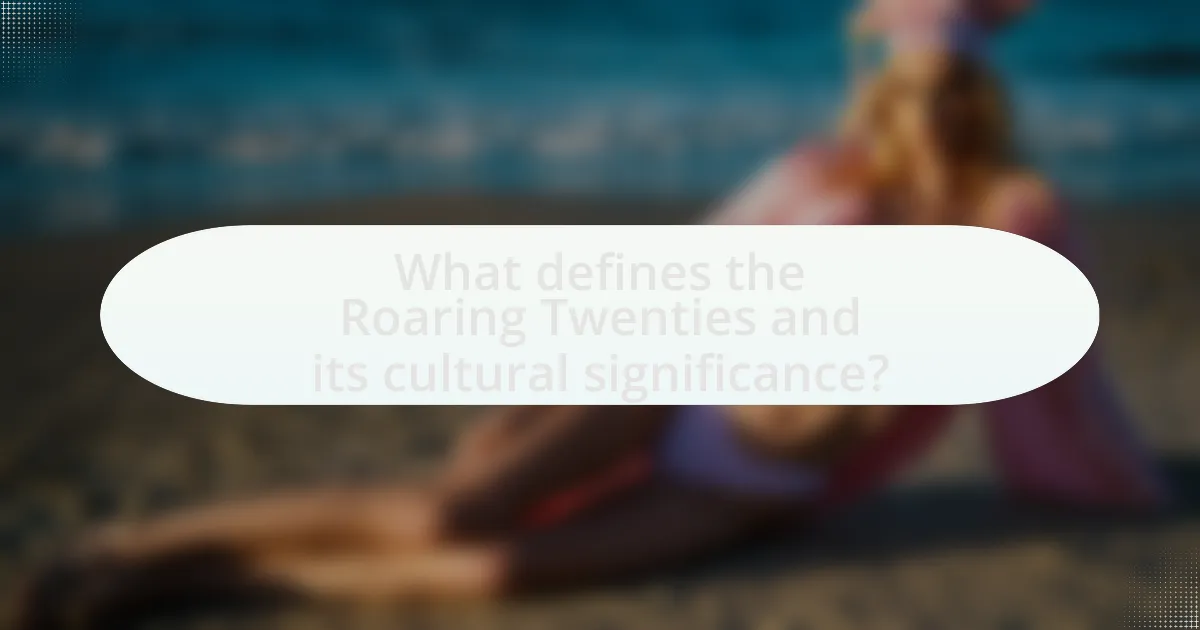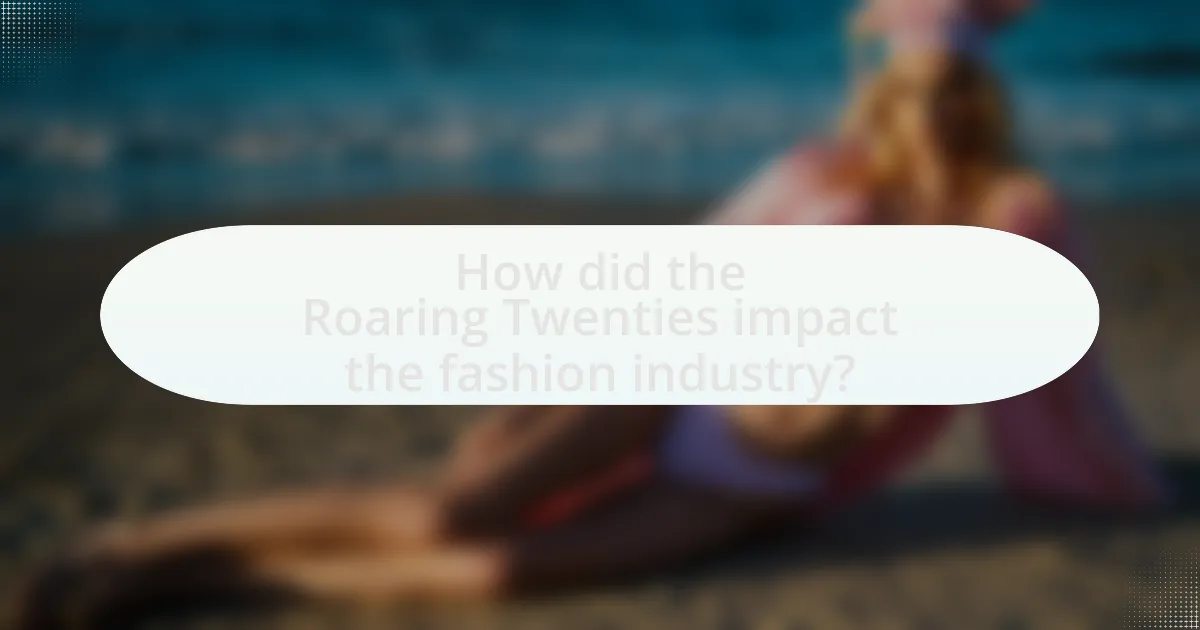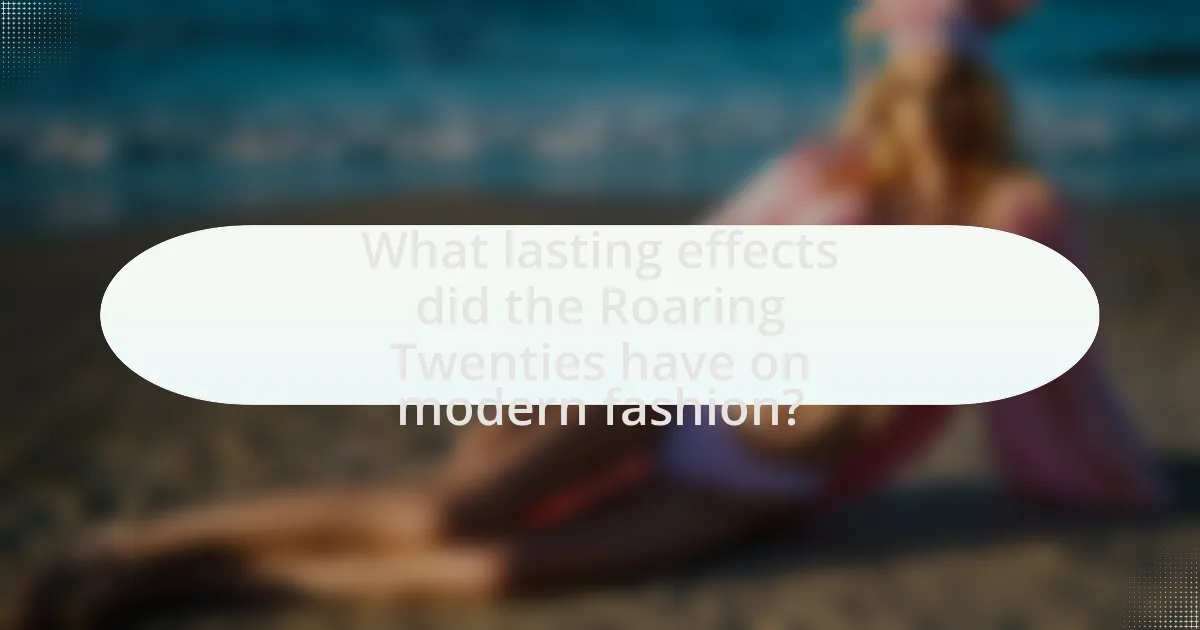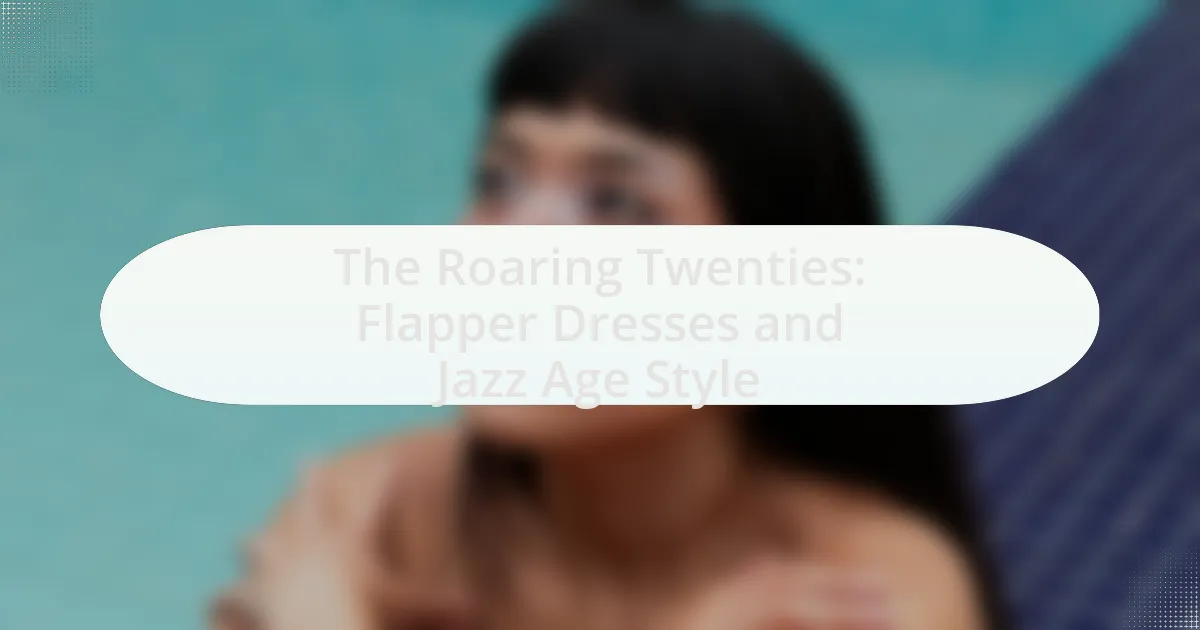The Roaring Twenties, a transformative decade in American history, is characterized by significant social, cultural, and economic changes, particularly through the rise of jazz music and flapper culture. This article explores the emergence of flapper dresses as symbols of women’s liberation, highlighting their influence on fashion trends, social dynamics, and the broader cultural landscape of the era. Key topics include the impact of economic prosperity on style, the role of women’s liberation in fashion evolution, and the lasting effects of 1920s aesthetics on contemporary clothing. Additionally, the article examines how jazz music shaped the lifestyle and fashion of the time, alongside the contributions of influential designers like Coco Chanel.

What defines the Roaring Twenties and its cultural significance?
The Roaring Twenties is defined by a period of significant social, cultural, and economic change in the United States, characterized by the rise of jazz music, flapper culture, and a break from traditional norms. This decade saw the emergence of new social freedoms, particularly for women, who embraced more liberated lifestyles, as evidenced by the popularity of flapper dresses and the widespread acceptance of jazz music in mainstream culture. The cultural significance of the Roaring Twenties lies in its role as a catalyst for modernity, reflecting shifts in attitudes toward gender roles, consumerism, and artistic expression, which were influenced by events such as the end of World War I and the economic prosperity of the time.
How did the social dynamics of the 1920s influence fashion?
The social dynamics of the 1920s significantly influenced fashion by promoting a break from traditional norms and embracing modernity, particularly through the emergence of the flapper style. This period, characterized by economic prosperity, the rise of youth culture, and changing gender roles, led to women adopting more liberated clothing that emphasized comfort and freedom of movement, such as shorter hemlines and looser silhouettes. The flapper dress, often adorned with fringe and beads, symbolized this shift, reflecting women’s newfound independence and participation in social activities like dancing and nightlife. Additionally, the influence of jazz music and the Harlem Renaissance contributed to vibrant colors and bold patterns in fashion, further showcasing the era’s cultural dynamism.
What role did women’s liberation play in the emergence of flapper dresses?
Women’s liberation significantly influenced the emergence of flapper dresses by promoting a new sense of freedom and independence for women in the 1920s. This movement encouraged women to reject traditional gender roles, leading to a desire for more practical and less restrictive clothing. Flapper dresses, characterized by their loose fit, shorter hemlines, and bold designs, symbolized this shift towards modernity and self-expression. The 19th Amendment, ratified in 1920, granting women the right to vote, further fueled this cultural transformation, as women began to assert their identities beyond domestic spheres. The flapper style became a visual representation of the changing social dynamics, reflecting women’s newfound autonomy and the broader cultural changes of the Jazz Age.
How did the economic prosperity of the 1920s affect style trends?
The economic prosperity of the 1920s significantly influenced style trends by promoting consumerism and the emergence of new fashion aesthetics. Increased disposable income allowed individuals to spend more on clothing, leading to the popularity of flapper dresses, which symbolized a break from traditional norms and embraced a more liberated lifestyle. The rise of department stores and mass production made fashionable clothing more accessible, while cultural shifts, such as the Jazz Age, inspired bold styles characterized by shorter hemlines, vibrant colors, and extravagant accessories. This period also saw the influence of Hollywood, which popularized glamorous styles through film, further driving fashion trends.
What are the key characteristics of flapper dresses?
Flapper dresses are characterized by their loose fit, dropped waistlines, and knee-length hemlines. These dresses often feature embellishments such as fringe, beads, and sequins, reflecting the vibrant and liberated spirit of the 1920s. The design allowed for ease of movement, aligning with the flapper lifestyle that embraced dancing and socializing. Historically, flapper dresses symbolized women’s emancipation during the Jazz Age, as they broke away from the restrictive fashions of previous decades, promoting a more modern and youthful aesthetic.
What materials and designs were commonly used in flapper dresses?
Flapper dresses commonly utilized materials such as silk, chiffon, and satin, characterized by their loose fit and dropped waistlines. These dresses often featured intricate designs, including beadwork, fringe, and sequins, which reflected the vibrant and liberating spirit of the 1920s. The use of lightweight fabrics allowed for ease of movement, aligning with the energetic dance styles of the era, such as the Charleston. Historical fashion sources indicate that the flapper dress was a symbol of women’s emancipation, showcasing a departure from the restrictive clothing of previous decades.
How did flapper dresses symbolize the changing role of women?
Flapper dresses symbolized the changing role of women by representing a shift towards greater freedom and independence in the 1920s. These dresses, characterized by their loose fit, shorter hemlines, and bold designs, reflected women’s rejection of traditional societal norms and their embrace of a more liberated lifestyle. The flapper movement coincided with women’s suffrage in the United States, where women gained the right to vote in 1920, further emphasizing their evolving status. The style of flapper dresses also signified a break from the restrictive clothing of previous eras, allowing women to move more freely and participate in social activities like dancing and nightlife, which were previously dominated by men.
Why is jazz music integral to the Jazz Age style?
Jazz music is integral to the Jazz Age style because it embodies the cultural and social dynamism of the 1920s. This genre emerged as a symbol of liberation and modernity, reflecting the era’s break from traditional norms. The popularity of jazz in dance halls and speakeasies facilitated a new social atmosphere where flappers and young people embraced freedom, self-expression, and a sense of rebellion against the past. The syncopated rhythms and improvisational nature of jazz paralleled the fast-paced lifestyle of the Roaring Twenties, making it a defining soundtrack for the period.
How did jazz influence the fashion and lifestyle of the 1920s?
Jazz significantly influenced the fashion and lifestyle of the 1920s by promoting a sense of freedom and modernity that was reflected in clothing styles and social behaviors. The emergence of jazz music coincided with the rise of the flapper culture, where women began to wear shorter dresses, bobbed their hair, and embraced a more androgynous look, symbolizing their newfound independence. This shift in fashion was characterized by the use of lighter fabrics, bold patterns, and accessories like cloche hats and long strands of pearls, which were popularized in jazz clubs and dance halls.
Moreover, jazz music fostered a vibrant nightlife, leading to the proliferation of speakeasies and social gatherings where people could express themselves freely. The influence of jazz on lifestyle was evident in the way people danced, socialized, and engaged in a more liberated culture, breaking away from the conservative norms of the previous decades. The cultural impact of jazz during this era is well-documented, with figures like Louis Armstrong and Duke Ellington shaping not only music but also the social fabric of the time, making jazz a defining element of the Roaring Twenties.
What cultural movements were associated with jazz during this era?
The cultural movements associated with jazz during the Roaring Twenties include the Harlem Renaissance and the emergence of the Jazz Age lifestyle. The Harlem Renaissance was a significant cultural, social, and artistic explosion centered in Harlem, New York, where African American artists, writers, and musicians celebrated Black culture and identity, with jazz being a central musical form. The Jazz Age lifestyle reflected a broader cultural shift towards modernity, characterized by a break from traditional values, increased social freedoms, and the rise of consumerism, all of which jazz music embodied through its improvisational style and vibrant social scenes.

How did the Roaring Twenties impact the fashion industry?
The Roaring Twenties significantly transformed the fashion industry by introducing bold styles that emphasized freedom and modernity. This era saw the rise of flapper dresses, characterized by their loose fit, dropped waistlines, and shorter hemlines, which symbolized women’s liberation and a break from traditional norms. The popularity of jazz music influenced fashion trends, leading to vibrant colors, extravagant embellishments, and the use of new materials like silk and rayon. Additionally, the decade marked the emergence of iconic designers such as Coco Chanel, who popularized the “little black dress,” further revolutionizing women’s fashion. The impact of the Roaring Twenties on fashion is evident in its lasting legacy, as it laid the groundwork for contemporary styles that continue to celebrate individuality and self-expression.
What were the major fashion trends of the 1920s?
The major fashion trends of the 1920s included flapper dresses, cloche hats, and tailored suits for men. Flapper dresses, characterized by their loose fit, dropped waistlines, and embellishments like beads and sequins, symbolized women’s liberation and the changing social norms of the era. Cloche hats, which were fitted and bell-shaped, became a staple accessory for women, complementing the bobbed hairstyles that gained popularity. Men’s fashion saw the rise of tailored suits, often featuring wide lapels and high-waisted trousers, reflecting a shift towards a more relaxed yet sophisticated style. These trends collectively represented the cultural dynamism and the spirit of the Jazz Age, as evidenced by the significant changes in societal roles and attitudes during this decade.
How did designers like Coco Chanel shape the flapper style?
Designers like Coco Chanel significantly shaped the flapper style by introducing a more relaxed silhouette and emphasizing comfort over the restrictive fashions of the past. Chanel’s designs featured dropped waistlines, shorter hemlines, and a boyish figure that embodied the flapper’s spirit of liberation and modernity. Her iconic use of jersey fabric allowed for greater movement, aligning with the flapper’s active lifestyle, which included dancing and socializing. Additionally, Chanel popularized the use of accessories like pearls and cloche hats, which became staples of flapper fashion. This transformation in women’s clothing not only reflected the changing social norms of the 1920s but also established Chanel as a pivotal figure in the evolution of modern women’s fashion.
What were the popular accessories that complemented flapper dresses?
Popular accessories that complemented flapper dresses included long strands of pearls, feathered headbands, cloche hats, and beaded handbags. These accessories were emblematic of the 1920s fashion, enhancing the overall aesthetic of flapper dresses, which were characterized by their loose fit and dropped waistlines. For instance, long pearl necklaces were often layered to create a dramatic effect, while cloche hats provided a stylish yet practical touch. Feathered headbands added a playful element, reflecting the era’s embrace of fun and freedom. Beaded handbags were not only fashionable but also functional, allowing flappers to carry essentials while maintaining their chic appearance.
How did the media portray flapper culture?
The media portrayed flapper culture as a symbol of modernity and liberation, emphasizing the flapper’s defiance of traditional gender roles. Publications like Vogue and The New Yorker celebrated flappers for their bold fashion choices, such as short dresses and bobbed hair, which represented a break from Victorian norms. Additionally, the media often depicted flappers as carefree and rebellious, engaging in activities like smoking, drinking, and dancing, which were seen as a rejection of conservative values. This portrayal was reinforced by the widespread coverage of jazz music and dance clubs, where flappers were frequently featured, highlighting their role in the cultural transformation of the 1920s.
What role did film and literature play in popularizing flapper fashion?
Film and literature significantly contributed to the popularization of flapper fashion by showcasing the lifestyle and attitudes of the era. Iconic films such as “The Jazz Singer” (1927) and literary works like F. Scott Fitzgerald’s “The Great Gatsby” (1925) depicted flappers as modern, liberated women who embraced bold styles, including shorter hemlines and boyish silhouettes. These visual and narrative representations influenced public perception and inspired women to adopt flapper fashion as a symbol of independence and rebellion against traditional norms. The widespread distribution of these films and books through theaters and print media ensured that flapper fashion became a cultural phenomenon, reflecting the changing social dynamics of the Roaring Twenties.
How did advertisements influence public perception of flapper style?
Advertisements significantly shaped public perception of flapper style by promoting the image of the modern, liberated woman. Through magazines and billboards, advertisements showcased flapper dresses, bobbed hairstyles, and accessories, which symbolized freedom and rebellion against traditional norms. For instance, popular publications like Vogue and Harper’s Bazaar featured flapper fashion prominently, influencing societal views and encouraging women to adopt this new style. The portrayal of flappers in advertisements not only highlighted their boldness but also linked the flapper aesthetic to a sense of empowerment, thereby normalizing and popularizing the look across various demographics.

What lasting effects did the Roaring Twenties have on modern fashion?
The Roaring Twenties significantly influenced modern fashion by introducing styles that emphasized freedom, individuality, and a break from traditional norms. The flapper dress, characterized by its loose fit, dropped waist, and embellishments, set a precedent for contemporary women’s fashion that values comfort and self-expression. Additionally, the era popularized bold patterns, vibrant colors, and accessories like cloche hats and long strands of pearls, which continue to inspire current fashion trends. The cultural shift towards modernity during the 1920s also encouraged designers to experiment with new materials and silhouettes, leading to the diverse and innovative fashion landscape we see today.
How do contemporary styles reflect the influence of the 1920s?
Contemporary styles reflect the influence of the 1920s through the revival of flapper aesthetics, Art Deco patterns, and the incorporation of jazz-inspired elements in fashion and design. Designers today often draw inspiration from the bold silhouettes and vibrant colors characteristic of the 1920s, such as the use of fringe, sequins, and geometric motifs that were prevalent during the Jazz Age. For instance, the resurgence of drop-waist dresses and cloche hats in modern collections showcases a direct lineage to the flapper style, which emphasized a more liberated and youthful silhouette. Additionally, the popularity of jazz music and its cultural significance during the 1920s continues to inspire contemporary fashion, as seen in the use of musical themes and motifs in clothing and accessories. This connection is further evidenced by fashion shows and collections that explicitly reference the Roaring Twenties, highlighting the enduring legacy of that era in today’s style landscape.
What elements of flapper fashion are still present in today’s clothing?
Elements of flapper fashion that are still present in today’s clothing include the use of fringe, drop waist silhouettes, and bold patterns. Fringe, which was popularized by flapper dresses to create movement, can be found in modern garments such as skirts and jackets. The drop waist silhouette, characterized by a lower waistline that creates a relaxed fit, has re-emerged in contemporary fashion, particularly in dresses and tunics. Additionally, bold patterns, including geometric designs and vibrant colors, continue to influence current fashion trends, reflecting the playful spirit of the 1920s. These elements demonstrate the lasting impact of flapper fashion on modern style.
How has the representation of the Jazz Age evolved in modern media?
The representation of the Jazz Age in modern media has evolved to emphasize both nostalgia and critical reflection on the era’s social dynamics. Contemporary films, television shows, and literature often portray the Jazz Age as a time of liberation and cultural innovation, highlighting the flapper lifestyle and the rise of jazz music. For instance, Baz Luhrmann’s 2013 film adaptation of “The Great Gatsby” showcases the opulence and excess of the 1920s while also critiquing the underlying social inequalities of the time. Additionally, modern media often incorporates diverse perspectives, including those of marginalized groups, which were historically overlooked, thereby enriching the narrative of the Jazz Age. This evolution reflects a broader trend in media to not only celebrate historical periods but also to interrogate their complexities and contradictions.
What lessons can we learn from the fashion of the Roaring Twenties?
The fashion of the Roaring Twenties teaches us the importance of self-expression and breaking societal norms. During this era, flapper dresses symbolized women’s liberation, reflecting a shift towards more daring and individualistic styles. The adoption of shorter hemlines and looser silhouettes represented a rejection of the restrictive clothing of previous decades, showcasing a newfound freedom in both fashion and social roles. This period also emphasized the influence of cultural movements, such as jazz, which inspired bold patterns and vibrant colors in clothing. The embrace of these styles illustrates how fashion can serve as a powerful medium for social change and personal identity.
How can understanding 1920s fashion inform current fashion trends?
Understanding 1920s fashion can inform current fashion trends by highlighting the era’s emphasis on bold styles, gender fluidity, and the celebration of individuality. The 1920s introduced flapper dresses, which featured dropped waistlines and loose silhouettes, reflecting a shift towards more relaxed and comfortable clothing that resonates with today’s casual chic aesthetic. Additionally, the use of vibrant colors, intricate beadwork, and art deco patterns from that decade can be seen in contemporary designs, as modern fashion often revisits and reinterprets historical styles. The 1920s also marked a significant cultural shift where women began to embrace more masculine styles, a trend that continues to influence gender-neutral fashion today. This historical context demonstrates how the innovative spirit of the 1920s continues to inspire designers and consumers alike, making it relevant in today’s fashion landscape.
What are some tips for incorporating flapper-inspired elements into modern wardrobes?
To incorporate flapper-inspired elements into modern wardrobes, focus on key pieces such as drop-waist dresses, fringe details, and bold accessories. Drop-waist dresses, which were popular in the 1920s, can be found in contemporary styles that maintain the silhouette while using modern fabrics. Fringe details can be added through skirts, tops, or even handbags, creating movement and a playful aesthetic reminiscent of the era. Additionally, accessories like cloche hats, long pearl necklaces, and feathered headbands can enhance the flapper look without overwhelming a modern outfit. These elements not only pay homage to the Roaring Twenties but also blend seamlessly into today’s fashion trends.

Leave a Reply